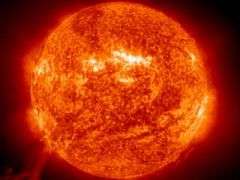Trying to spot differences in the sun

The sun is the focus of a deepening mystery. Solar scientists want to know: Why is the sun so quiet?
So-called sunspots, intense solar storms that eject mass amounts of energy and darken the solar surface, have been all but missing the last two years. Typically, the more spots, the more energy the sun gives off.
What effect this might have on world climate is unclear. Earth's atmosphere and the sun have had a long and complex relationship, and scientists acknowledge they still are not sure precisely what goes on between them.
But changes in the deceptively volatile star evidently do have some impact on the planet's weather.
Sunspots have been tied to everything from droughts to wine vintages to the sinking of the Titanic. A sunspot lull correlated with the Little Ice Age -- from the 14th through 19th centuries -- when "Greenland" became a misnomer.
Recently, the sun has been ever-so-subtly weaker than usual. Last year, 266 days were spot-free, and not a single spot was detected in August, said David Hathaway, a NASA expert in Huntsville, Ala. And while 2008 was one of the warmest years on record worldwide, it was the coolest since 2000.
"The current minimum is now the longest we have seen," said Ken Tapping, a scientist with the Penticton, Canada, Herzberg Institute of Astrophysics, which has been tracking sunspots since 1947.
NASA is forecasting the sun's activity will pick up before the end of the year. "However, we are now getting into new territory," Tapping said. The solar lull was supposed to have ended months ago.
Sunspots typically follow 11-year cycles of lull, crescendo, lull. But, like EPA gas-mileage estimates, 11 years represents a rough range. Cycles can vary from nine to 14 years.
Tapping cautions against reading too much into recent observations, or even those that date to Galileo, who first noticed them. In the old days, observers tracked them by projecting solar images onto paper, and the technology has improved tremendously since World War II.
But the period of sun-spotting by earthlings, he notes, is "very small compared with the 4.5 billion-year life of the sun."
What's more, no one yet has quite figured how to isolate the effects of solar variations from other forces that drive the climate system, such as volcanic ash, seesawing temperatures in the tropical Pacific Ocean, and human activity.
"How much the sun affects short-term weather is really not known," said Caspar Ammann, a climate specialist at the National Center for Atmospheric Research in Boulder, Colo. "A lot of speculation exists, but I would caution and doubt any conclusions."
Although the sun is by no means a steady star, the range of change in solar output is only on the order of 0.2 percent, the experts say.
Fred House, a solar-energy specialist at Drexel University, says the total wattage beamed at the top of the atmosphere over a square meter is equivalent to about 13 100-watt light bulbs directed at a card table. Remove 0.2 percent of that wattage, and you'd probably still be able to see the cards.
How these tiny changes work their way into the climate system is "the million-dollar question," Tapping says. "The first step -- what the sun does at the top of the atmosphere -- is a relatively simple thing, but what the atmosphere does with it is very complicated."
The U.N. Intergovernmental Panel on Climate Change estimates that solar fluctuations have about one-fifth the climate impact of human greenhouse gases but cautions that that is based on a "low level of understanding."
That said, the current lull could have some effect on Earth's temperatures for the next two years or so, according to NASA's Goddard Institute for Space Studies in New York City. Don't expect another ice age, though, according to the agency.
To put the last two years in perspective, Hathaway says that sunspots were absent in 31 of the 70 years from 1645 to 1715, in the cold heart of the Little Ice Age, with none sighted from 1661 to 1671.
The infamous "year without a summer," 1816, coincided with another lull from 1798 to 1825. But that chilly summer followed the cataclysmic eruption of Tambora in Indonesia, which cast a sun-screening veil across the atmosphere.
More recently, 1911 to 1913 all had more than 200 spotless days each, with 1913 having 314. One British researcher has suggested that the lack of sunspots may have contributed to the formation of the iceberg that sunk the Titanic in 1912, but Hathaway says the lull does not show up in temperature records.
Given the long career of the sun and the relatively short period of observation, Tapping said it was unrealistic for anyone to expect the sun to give up its secrets.
"It's like walking into town, taking a photograph, and trying to deduce what's going on," he said.
___
(c) 2009, The Philadelphia Inquirer.
Visit Philadelphia Online, the Inquirer's World Wide Web site, at www.philly.com/
Distributed by McClatchy-Tribune Information Services.




















